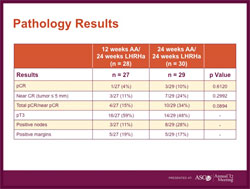BERKELEY, CA (UroToday.com) -
at the ASCO Annual Meeting
 Approximately 20% of all localized prostate cancers are in the high-risk category, and cure rates with standard treatment approaches of radical prostatectomy and radiation are sub-optimal. In fact, as demonstrated by Albertson, et al., the natural history of Gleason Score 8 or greater prostate cancer, when untreated, results in prostate cancer-related deaths over competing causes, in all age groups - and especially in the younger patient. To further underscore the poor prognosis of high Gleason scores, Stephenson, et al. published longitudinal outcomes from several large prostatectomy cohorts and demonstrated that one-third of patients with Gleason score 8, 9 or, 10 prostate cancer will have died from prostate cancer at 15 years.
Approximately 20% of all localized prostate cancers are in the high-risk category, and cure rates with standard treatment approaches of radical prostatectomy and radiation are sub-optimal. In fact, as demonstrated by Albertson, et al., the natural history of Gleason Score 8 or greater prostate cancer, when untreated, results in prostate cancer-related deaths over competing causes, in all age groups - and especially in the younger patient. To further underscore the poor prognosis of high Gleason scores, Stephenson, et al. published longitudinal outcomes from several large prostatectomy cohorts and demonstrated that one-third of patients with Gleason score 8, 9 or, 10 prostate cancer will have died from prostate cancer at 15 years.
This forms the basis for the rationale of the study. An adjuvant or neoadjuvant therapy is needed in the treatment of high-risk and especially in high Gleason score prostate cancer patients.
By definition, high-risk prostate cancer patients have a PSA > 20, Gleason scores 8 to 10 and stage T3 disease.
The patients in this cohort had unfavorable, high-risk disease. 71% of the patients had Gleason scores of greater than 8 and 18% occult positive lymph nodes at prostatectomy.
Participants in this trial were randomized to either leuprolide alone, or to leuprolide plus abiraterone acetate and 5 mg of prednisone (dosed once daily).
After 3 months, participants in each group had a prostate biopsy for measurements of tissue androgens and these measurements were the primary endpoint of the trial.
After the prostate biopsy, all patients in both groups were treated with three additional months of leuprolide plus abiraterone acetate and 5 mg of prednisone (dosed once daily), after which prostatectomy was performed.
Fifty-eight patients were enrolled over 20 months. Among men treated with leuprolide plus abiraterone acetate and 5 mg of prednisone, 34% had either complete elimination or near complete elimination of their cancer upon surgery. These results are higher than historic controls. Of those treated with leuprolide alone for the first 12 weeks and then with three additional months of leuprolide plus abiraterone acetate plus prednisone, 15% of men had either complete elimination or near complete elimination of their cancer upon surgery. Therapy was well tolerated by both groups.
These data demonstrate that six months (not three) of neoadjuvant therapy is feasible and that leuprolide plus abiraterone acetate plus prednisone significantly lowers tissue androgens versus LHRHa alone. Further, leuprolide plus abiraterone acetate plus prednisone has low systemic and surgical toxicity. Prednisone at 5 mg per day in this treatment prevents symptoms of increased ACTH.
The long-term significance of these data requires further study.

Mary-Ellen Taplin, MD
Associate Professor of Medicine, Harvard Medical School
Dr. Taplin received her MD in 1986 from the University of Massachusetts, Worcester. She completed a residency in internal medicine and chief residency at the University of Massachusetts Medical Center and an oncology-hematology fellowship at Beth Israel Hospital and Harvard Medical School.
Dr. Taplin was on staff in medical oncology-hematology as an assistant and then associate professor of medicine at the University of Massachusetts from 1993 to 2003, when she joined Dana-Farber Cancer Institute.
View the complete slide presentation: Effect of Neoadjuvant Abiraterone Acetate Plus Leuprolide Acetate on PSA, Pathological Complete Response (pCR), And Near pCR in Localized High-Risk Prostate Cancer: Results of a Randomized Phase 2 Study







